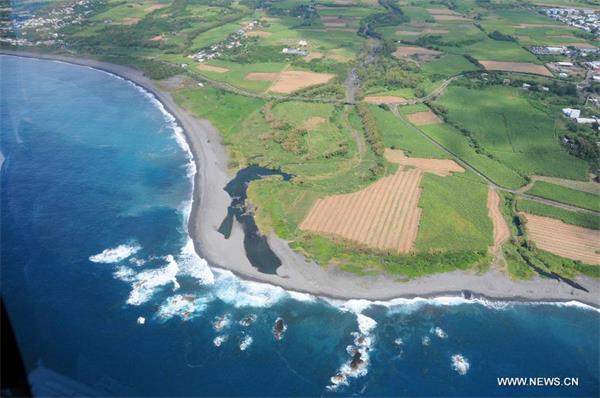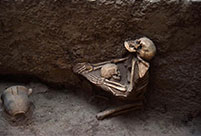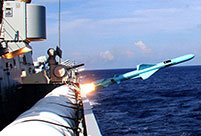


Aerial Photo taken on Aug. 9, 2015 shows the eastern coast of France's overseas island La Reunion in the Indian Ocean. France on Aug. 7 announced that hunts for more MH370debris will continue for at least a week off la Reunion after a wing section was spotted near the island. (Xinhua/Zhang Chuanshi)
BEIJING, Aug. 11 -- Malaysia will send a team to the Maldives to determine whether the debris spotted near the Indian Ocean island came from the missing Malaysia Airlines MH370, Transport Minister Liow Tiong Lai said Monday.
The minister also said it was premature to connect the unidentified debris to the doomed plane, which disappeared on March 8, 2014, with 239 people aboard flying from Kuala Lumpur to Beijing.
"At this juncture, no verification of the debris has taken place," Liow said.
Local media reported that a piece of object, probably a plane part which is five to seven inches long, was discovered on a private beach in the Maldives in May.
The Maldives has joined a regional search as local police have been responding to the sightings.
Meanwhile, the search continues in the French Indian Ocean island of La Reunion after a wing component called a flaperon was spotted in the eastern part of the French overseas island and was confirmed by Malaysia as part of the missing plane later.
However, no clues to more debris have been found since Friday's massive hunt, La Reunion authorities confirmed in a statement Monday.
The statement said the tridimensional search on the island, in which air, pedestrian and maritime forces were deployed, will last until this Friday.
Meanwhile, the Indian Ocean nation of Mauritius, which is located 190 kilometers northeast of La Reunion, pledged to continue search operations in its waters, Deputy Prime Minister Xavier-Luc Duval told Xinhua Monday.
Mauritius joined the search one week ago, deploying coastguard ships and asking fishermen to report any possible debris.
However, 17 months on since the plane went missing, search operations face mounting challenges in spite of the evidence that has emerged.
The wing part discovered on La Reunion offered some hope to locate MH370's final resting place. However, scientists could not narrow down the plane's crash site based on a single floating object via reverse calculation.
Only by finding at least 30 to 50 pieces of debris would it be possible to retrace where the plane hit the water, said Jian Jun, a Chinese oceanography expert from Dalian Maritime University.
Jian said it's not an easy job to find enough wreckage in the Indian Ocean, a vast area with wild gales and complicated ocean currents.
Besides, there are only two inhabited archipelagos between the western Australian shore and La Reunion, making it especially difficult to spot debris from other islands.
Jian suggested the Australian-led search team continue combing over a 120,000-square-kilometer search zone, which was confirmed through satellite data to pinpoint the plane's path.
The search for the black box is still the core objective, as the data within it is key to solving all the mysteries, said Graham Braithwaite, an aviation security expert at Britain's Cranfield University.
But as the batteries had run out, the black box was not sending anymore signals, making the underwater search "blind."
David Gallo, who co-led the search for Air FranceFlight 447 that crashed in the Atlantic Ocean in 2009, said it's most likely that the black box lies somewhere on the sea floor.
Compared to a surface search, an underwater search takes longer and needs much more luck, said Gallo, who now works as director at the U.S. Woods Hole Oceanographic Institution.
Since 1965, black boxes from 19 crashed planes have not been found yet, including that of MH370.
The black box, which records flight data and cockpit voice, could sustain explosions and seawater. It's believed that the black box is virtually indestructible and would help analyze the causes of air accidents.
Still, further clues might emerge from the wreckage found on La Reunion. Gallo said that barnacles attached to the debris are important clues to finding the ill-fated plane.
The size of barnacles, crustaceans that live stuck to hard surfaces under sunlight, could tell how long the debris had been in the water.
Scientists could also analyze which part of the ocean the debris came from through the species of barnacles as chemicals inside the barnacles could vary in different waters.
 Shocking scenes found in 4000-year-old earthquake relic
Shocking scenes found in 4000-year-old earthquake relic Female soldiers add color to military parades
Female soldiers add color to military parades Taiwan campus belle with gorgeous look
Taiwan campus belle with gorgeous look  Stunning photos of China’s fighters and airborne troops
Stunning photos of China’s fighters and airborne troops Mums stage breastfeeding flash mob
Mums stage breastfeeding flash mob PLA South China Sea Fleet conducts live fire exercise
PLA South China Sea Fleet conducts live fire exercise Beauty of Tsinghua University transforms into car model
Beauty of Tsinghua University transforms into car model Official shot having sex with two college girls
Official shot having sex with two college girls Moscow “spider-man” climbs Chinese skyscraper
Moscow “spider-man” climbs Chinese skyscraper Daring duo
Daring duo Sorry is the hardest word for Abe
Sorry is the hardest word for Abe Coolest ice structures from around the globe
Coolest ice structures from around the globe Pecs appeal Shirtless male models flex their promo power
Pecs appeal Shirtless male models flex their promo powerDay|Week